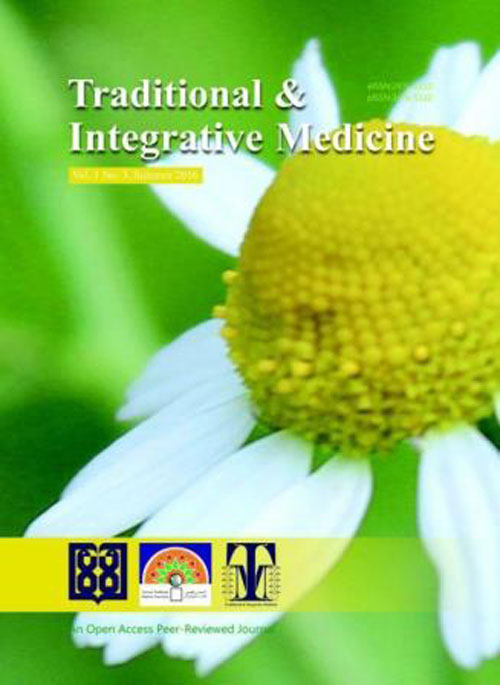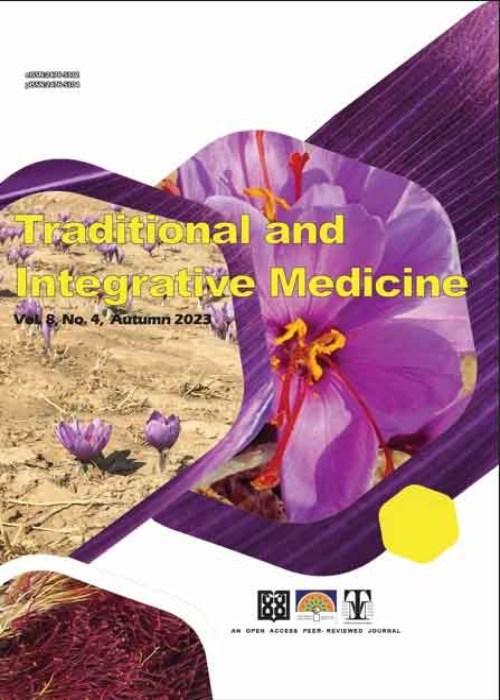فهرست مطالب

Traditional and Integrative Medicine
Volume:1 Issue: 3, Summer 2016
- تاریخ انتشار: 1395/07/17
- تعداد عناوین: 8
-
Pages 87-89
-
Pages 90-95This study was designed to compare the findings of hysterosalpingography and garlic test to assess the fallopian tubes and uterus for diagnosis of obstruction in internal female genital tract. This survey was done using the database from 50 infertile women assessed for infertility both via hysterosalpingography and garlic test. The concordance between the two tests was evaluated using overall agreement percent and kappa coefficient. The sensitivity and specificity for garlic test were 56% and 75%, respectively, with 60% positive and 72% negative predictive values. The concordance between the two assays was 67.5% with a corresponding coefficient of 31%. Thus, it seems that garlic test is an easy, noninvasive and safe method. Specificity and negative predictive value of garlic test is relatively suitable but its diagnostic sensitivity and positive predictive value is not high. It can be repeated during infertility treatment for several times and seems to have favorable compliance by the patient compared to hysterosalpingography.Keywords: Garlic test, Hysterosalpingography, Avicenna, Iranian traditional medicine, Female infertility
-
Pages 96-100The genus Ajuga is used for the treatment of joint pain, gout, jaundice, and wound healing in Iranian traditional medicine. Ajuga chamaecistus ssp. tomentella is an exclusive subspecies of Ajuga chamaecistus in the flora of Iran. Plants belong to Ajuga species are advantageous sources of phytoecdysteroids. 20-hydroxyecdysone (20E) is an important phytoecdysteroid with anabolic property. This study aimed to determine and quantify 20E in methanolic extract of aerial parts of Ajuga chamaecistus ssp. tomentella. The standard reference of 20E was isolated from n-butanolic fraction of aerial parts of Ajuga chamaecistus ssp. tomentella using high-performance liquid chromatography (HPLC). The analysis was carried out on an ODSA (C18) column with isocratic elution using wateracetonitrile (75:25). The standard calibration curve represented good linearity (r2 = 0.9997). The limit of quantification (S/N = 10) and detection (S/N = 3) were determined as 7.93 and 2.38 µg/ml, respectively. The content of 20E in methanolic extract of Ajuga chamaecistus ssp. tomentella was determined to be 2.58% (w/w) (0.46% in dry plant). The quantitative proportion of the 20E found in Ajuga chamaecistus ssp. tomentella extract proposes the possible uses of this plant in commercial formulations or as a source of 20E.Keywords: Ajuga chamaecistus ssp. tomentella, 20, hydroxyecdysone, Quantification, High, performance liquid chromatography (HPLC
-
Effects of Galbanum Oil on Patients with Knee Osteoarthritis: A Randomized Controlled Clinical TrialPages 101-107Knee osteoarthritis is considered as a major public health issue causing chronic disability worldwide with the increasing number of aging people. Many sufferers with knee osteoarthritis are using complementary and alternative medicine including herbal drug, herbal patch, etc. This research aimed to compare the efficacy of galbanum oil in the management of knee osteoarthritis with diclofenac gel using parallel randomized controlled design. In this randomized controlled trial (RCT), 32 patients with chronic knee pain due to osteoarthritis were randomly allocated into two equal groups. The intervention group received topical galbanum oil and control group received topical diclofenac gel. The drugs were given for 1 month, 3 times per day. Outcomes were assessed using Persian version of Western Ontario McMaster University Osteoarthritis Index (WOMAC) and visual analog scale (VAS). No statistically significant difference was observed between the topical galbanum oil and topical diclofenac gel regarding knee pain, morning stiffness and physical function over the 1- and 2-months follow-up period. It seems that using topical galbanum oil is clinically effective for patients suffering from knee osteoarthritis in order to decrease their pain, morning stiffness and limited function; its effect is comparable with topical diclofenac gel. Considering lesser side effects of galbanum and its herbal base, it may be a better choice compared to topical diclofenac in management of the pain of knee osteoarthritis at least in short term.Keywords: Ferula gummosa, Galbanum oil, Knee osteoarthritis, Pain, Morning stiffness
-
Pages 108-117Medicinal oils were of the pharmaceutical dosage forms used since ancient Persian times to now in Iran. Chamomile oil is one of the medicinal oils prepared by the extraction of the chamomile flowers to sesame oil as an oily vehicle. It was widely used in the history of Persian medicine and is currently used by traditional practitioners of Persian Medicine in various disorders mainly in topical form. In this study, traditional chamomile oil was prepared based on the Qarabadin books. In advanced, 600 g of chamomile flower powder was boiled in 3.6 liter of water for 3 hours. Then, powder was removed and remained water (aqueous extract of chamomile) was boiled with 0.5 liter of sesame oil for 2 hours (until all the water was vaporized and oil remained). For standardization, the essential oil of chamomile oil was obtained via Clevenger apparatus method and then analyzed with the help of gas chromatography (GC)-mass method. In addition, total phenolic and flavonoid contents of the chamomile oil were calculated based on galic acid and quercetin, respectively. The results show that the main component of the essential oil were Caryophyllene (7.45%), Bisabolol Oxide B (2.05%), Bisabolone Oxide A (62.35%), Chamazulene (2.05%), Bisabolol Oxide A (15.54%) and Methyl ester 5,8,11-Heptadecatriynoic acid (5.52%). Besides, total phenolic and flavonoid contents were 11.0043 ± 0.4514 and 2.7640 ± 0.1776 mg/l, respectively. Our results show that the historical dosage form of chamomile oil in Persian medicine can be reproduced and is an stable and homogeneous oil and be standardized in our investigation.Keywords: Persian Medicine, Chamomile oil, Pharmaceutic, Traditional medicine
-
Pages 115-121Physical exercise acts as a mechanical stressor that can provoke biochemical alterations. Accordingly, muscular effort is able to modify blood concentrations in some cellular enzymes. Cupping is one of the traditional methods used to restore and revive the balance of the budy. This study aimed to evaluate the impact of cupping and a practice session on the level of some liver enzymes in men handball team members of Zahedan city, Iran. The participants were all the members of the Zahedan men handball team with the mean age of 23.66 ± 5.86 years, mean height of 177.19 ± 4.58 cm, mean weight of 80.12 ± 12.58 kg and mean body mass index (BMI) of 24.53 ± 3.60 kg/m2. All the team members, as the samples, were chosen via voluntary sampling method on a voluntary basis. They were randomly positioned into two groups of training (n = 12) and cupping (n = 10). Serum concentrations of creatine kinase (CK) and lactate dehydrogenase (LDH) were measured before and immediately and 24 hours after the training and cupping using the enzyme-linked immunosorbent assay (ELISA) methods. Data were analyzed using independent-t test and multi variety. There was a significant difference between the average concentration of the enzymes in before, next, and 24 hours after the test. According to the results of this study, the exercise and cupping caused muscle damage and increased the damage markers in bloodKeywords: Cupping, Exercise, Creatine kinase (CK), Lactate dehydrogenase (LDH)
-
Pages 122-128Cydonia oblonga Mill is commonly known as quince. It seems to have been used since the ancient time. Quince is a popular fruit because of its health promoting properties. It is an undeniable fact that there is a positive relationship between a diet rich in plant foods and a diminish incidence of cancer, cardiovascular and other diseases. The aim of this study was demonstrating pharmacologic properties of quince (pulp and peel), view of Iranian traditional medicine (ITM) and modern phytotherapy. For this purpose, Pubmed, Elseveir, Scopus, SID and Google scholar were searched for the key terms Cydonia oblonga and Quince up to 20st June 2015, and also Iranian traditional medicine manuscripts and herbal medicine books were studied. All experimental and animal studies that included the evidences of fruit (pulp and peel) written in this article were selected for review. Quince has various pharmacological properties including antioxidant, anti-allergic, anti-inflammatory, anticancer, antibacterial, and anticolitis properties and effects on blood pressure and blood rheology, and also has several traditional medicine uses. In Iranian traditional medicine, quince pulp is effective on the most important and vital organs like brain, heart and liver. This fruit is a valuable source of compounds with health-promoting properties and can be used as good sources of antioxidants in our diet and may have use in the prevention and treatment of heart, brain and gastrointestinal diseases.Keywords: Cydonia oblonga, Phytotherapy, Quince, Traditional medicine, Pharmacology, Phytochemistry
-
Pages 129-131Adiantum Capillus veneris L. from the family Polypodiaceae, is one of the medicinal herbs used in Iranian traditional medicine (ITM). It has been identified as Parsiavashan in Iranian traditional medicine and commonly known as Maidenhair fern in English. Triterpenoids and flavonoids are the major compounds identified in Maidenhair fern. It has been used in Iranian traditional medicine for treating respiratory tract diseases, irregular menstruation, flatulence, jaundice, splenomegaly and scrofula. It has been topically used in skin and hair disorders, too. The pharmacological activities reported from this plant are anti-inflammatory, antinociceptive, antimicrobial, antidiabetic, diuretic and antioxidant. However, there is not direct relationship between pharmacological activities of this plant in Iranian traditional medicine and modern phytotherapy; the anti-inflammatory and antimicrobial properties of this plant could make it useful for respiratory tract disorders. Anyway, it is recommended to design experimental and clinical studies on pharmacological activities and indications of Adiantum capillus veneris mentioned in Iranian traditional medicine literatures.Keywords: Adiantum Capillus veneris, Iranian traditional medicine, Parsiavashan, Maidenhair fern, Phytotherapy


